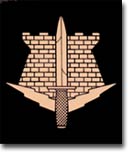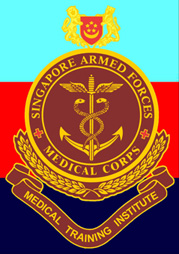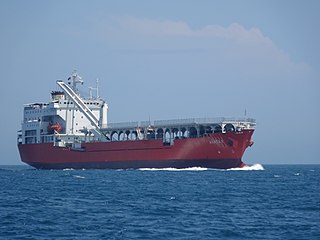
Chemical, biological, radiological and nuclear defense or NBC protection is protective measures taken in situations in which chemical, biological, radiological or nuclear hazards may be present. CBRN defense consists of CBRN passive protection, contamination avoidance, and weapons of mass destruction mitigation.

The Singapore Armed Forces (SAF) are the military of the Republic of Singapore, responsible for protecting and defending the security interests and the sovereignty of the country. A component of the Ministry of Defence (MINDEF), the armed forces have four service branches: the Army, Navy, Air Force, and Digital and Intelligence Service. An integrated force, it is one of the most capable, robust, technologically sophisticated and powerful militaries in the Southeast Asia region. The SAF is headed by the chief of defence force, appointed by the president of Singapore, on the advice of the Cabinet.
Counter-terrorism in Singapore is a series of detection and prevention measures to minimize the damage caused by terrorism. These measures involve the participation of all levels of society, including defence, internal security, border and infrastructure security, civil defense, and gives special focus on areas such as medical readiness and psychological preparedness.

The Special Operations Engineer Regiment (SOER) is a specialised unit of the Australian Army. The regiment forms part of the Special Operations Command. The unit was formed in 2002 as the Incident Response Regiment (IRR), they are deployed to respond to chemical, biological, radiological, nuclear or explosive incidents. The regiment was transferred into the newly raised Special Operations Command in 2003. In 2010 and 2011, its role changed to supporting the army's special forces units, and it was renamed accordingly.

The Singapore Combat Engineers (SCE) is a formation of the Singapore Army. Combat Engineers provide mobility by bridging gaps and clearing minefields to facilitate speedy advance of troops into enemy territory, and counter-mobility by constructing obstacles such as anti-tank ditches to impede the enemy's movement. The Combat Engineers also construct trenches, drainage systems and other related infrastructure to enhance the survivability of troops during operations.

Canadian Special Operations Forces Command is a command of the Canadian Armed Forces. It is responsible for all special forces operations that respond to terrorism and threats to Canadians and Canadian interests around the world.

The SAF Medical Training Institute (SMTI) is a military medicine training institute under the Army Medical Service within the SAF Medical Corps. As part of the medical corps, the institute oversees the medical vocational training for SAF service members under the Army, Navy, Air Force, as well as the Singapore Civil Defence Force.

Visit, board, search, and seizure (VBSS) is the term used by United States military and law enforcement agencies for maritime boarding actions and tactics. VBSS teams are designed to capture enemy vessels, combat terrorism, piracy, and smuggling, and to conduct customs, safety and other inspections.
National Counter-Terrorism Exercises involve the Australian Federal Government and all States and Territories designed to test Australia's counter-terrorism response arrangements. Australia's national counter-terrorism arrangements are well practised with major exercises held annually. The Department of Home Affairs manages the Counter-Terrorism Capability Branch in the Centre for Counter-Terrorism Coordination which supports the Australia-New Zealand Counter-Terrorism Committee (ANZCTC) who run the exercise program. The exercise was formerly named National Anti-Terrorism Exercise (NATEX).

The Defence Chemical, Biological, Radiological and Nuclear Centre is a United Kingdom military facility at Winterbourne Gunner in Wiltshire, south of Porton Down and about 4 miles (6 km) north-east of Salisbury. It is a tri-service location, with the Army being the lead service. The centre is responsible for all training issues relating to chemical, biological, radiological and nuclear (CBRN) defence and warfare for the UK's armed forces.

The Chemical Biological Incident Response Force (CBIRF) is a Marine Corps unit responsible for countering the effects of a chemical, biological, radiological, nuclear, or high-yield explosive (CBRNE) incident, support counter CBRN terrorism, and urban search and rescue when CBRN incident. They were activated in April 1996 by General Charles C. Krulak, then Commandant of the Marine Corps. The unit is based at Naval Support Facility Indian Head in Indian Head, Maryland and falls under the command of the United States Marine Corps Forces Command.
The National Security Coordination Secretariat (NSCS) is a unit under the Prime Minister's Office (PMO) of the Government of Singapore. Established in 1999, it was tasked to strengthen coordination amongst Singapore's existing security agencies; Singapore Armed Forces (SAF), Singapore Police Force (SPF), Internal Security Department (ISD) and Security and Intelligence Division (SID).

The Special Operations Task Force (SOTF) is a special operations command of the Singapore Armed Forces (SAF) responsible for conducting special operations. The SOTF is composed of only highly-trained regular servicemen from the Army's Special Operations Force (SOF) under the Commandos formation and, the Navy's Special Warfare Group (SWG) under the Naval Diving Unit (NDU).
Seletar Camp is a military installation used by the Singapore Army. It is located in the northern part of Singapore by the Tampines Expressway and adjacent to Punggol Reservoir. A small golf course and the newly established Seletar Aerospace Park are also on the former grounds of Seletar Camp. To free up land for future redevelopment, the Army Combat Engineers Group and its sub-units were consolidated into a 30-hectare site and the camp's main gate was relocated to St. Martin Lane. The opposite is the newly built Seletar Airport.

The Singapore Armed Forces Medical Corps is the medical corps of the Singapore Armed Forces (SAF) that provides medical services to the Army, Navy and Air Force. The Medical Corps establishes policies and directs the full implementation of quality force health, medical force protection, operational support, medical information technology, medical manpower and logistics, as well as its medical inspectorate within the Singapore Armed Forces.

MV Avatar was a general cargo vessel in service with the Republic of Singapore Navy as a training vessel. She is owned by Valour Offshore Marine Services and was leased to the Defence Science and Technology Agency from 2001-2023, a statutory board under the Ministry of Defence. Avatar was not a commissioned navy warship and flew the state marine ensign instead of the naval ensign.
The Maritime Security Task Force is a high-readiness standing task force of the Republic of Singapore Navy (RSN) responsible for maritime security operations.

The Digital and Intelligence Service (DIS) is the digital service branch of the Singapore Armed Forces (SAF) responsible for providing military intelligence to the armed forces, building up the country's digital defence capabilities, and protecting the psychological defence of its military personnel. It was established on 28 October 2022, in response to the increased number of attacks by non-state actors, and the resulting damage from the Russian–Ukrainian cyberwarfare.












